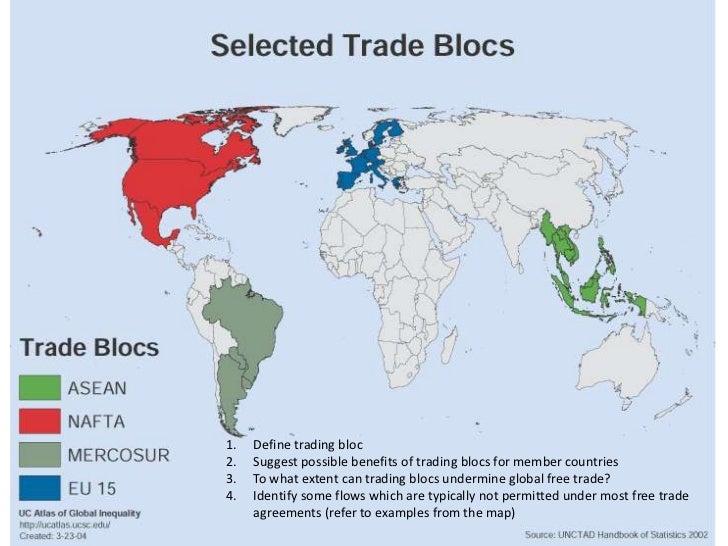
allies, is a windfall largely resulting from Trump's retreat from the TPP, said ING's Pang. The pact will take effect once enough participating countries ratify the agreement domestically within the next two years, Indonesia's trade minister said last week.įor China, the new group, including many U.S. RCEP "will help reduce or remove tariffs on industrial and agricultural products and set out rules for data transmission," said Luong Hoang Thai, head of the Multilateral Trade Policy Department at Vietnam's Ministry of Industry and Trade. "I'm not sure that there will be much focus on trade generally, including efforts to rejoin" the TPP successor grouping, "for the first year or so because there will be such a focus on COVID relief," Charles Freeman, senior vice president for Asia at the U.S.
#Trade blocs free
The deal marks the first time rival East Asian powers China, Japan and South Korea have been in a single free trade agreement.ĭespite being outside RCEP and having been in the administration that propelled the TPP, President-elect Joe Biden - Obama's vice president - is unlikely to rejoin the TPP anytime soon, analysts said, as his government will have to prioritize handling the COVID-19 outbreak at home. "For the first time, China and Japan reached a bilateral tariff reduction arrangement, achieving a historic breakthrough," the ministry said in a statement, without giving further details. There were no details on which products and which countries would see immediate reduction in tariffs. The deal was signed on the sidelines of an online ASEAN summit held as Asian leaders address tensions in the South China Sea and tackle plans for a post-pandemic economic recovery in a region where U.S.-China rivalry has been rising.Ĭhina's finance ministry said the new bloc's promises include eliminating some tariffs within the group, including some immediately and others over 10 years. It aims in coming years to progressively lower tariffs across many areas. RCEP groups the 10-member Association of Southeast Asian Nations (ASEAN), China, Japan, South Korea, Australia and New Zealand. The United States is absent from both RCEP and the successor to the Obama-led Trans-Pacific Partnership (TPP), leaving the world's biggest economy out of two trade groups that span the fastest-growing region on earth.īy contrast, RCEP could help Beijing cut its dependence on overseas markets and technology, a shift accelerated by a deepening rift with Washington, said Iris Pang, ING chief economist for Greater China. “Increasing trade will not only help middle-income economies develop but also drive growth around the world as the financial crisis recedes.Amid questions over Washington's engagement in Asia, RCEP may cement China's position more firmly as an economic partner with Southeast Asia, Japan and Korea, putting the world's second-biggest economy in a better position to shape the region's trade rules. “Pursuing stronger regional trade agreements can help form the building blocks for global free trade deals,” Foxley writes. The region should now expand its trade bloc to include China, Japan, and South Korea. East Asia: Despite a high number of trade agreements that make it difficult to resolve disputes and navigate the relevant rules, East Asia enjoys a successful trading history.Latin America: With their relatively strong fiscal positions, Latin American countries can expand on existing agreements by ending administrative restrictions and tariffs and coordinating investment in transportation, energy, and telecommunications.

Eastern Europe: The European Union-which bought 80 percent of Eastern Europe’s exported goods in 2008-can spur further regional growth by implementing policies that reduce deficits and regain lost competitiveness.And bottom-up approaches in which companies develop regional supply chains are more effective in improving regional integration than top-down approaches imposed by governments.

Using the findings from three vastly different experiences, Foxley says that regional trade agreements work best when participating countries have few political differences, coordinate their monetary and fiscal policies, and embrace globalization. In a report, Alejandro Foxley analyzes how three regions-Eastern Europe, Latin America, and East Asia-are increasing trade within their borders and building a broader free trade system.

With global trade talks stalled and lower demand from major economies that were hit hard by the global economic crisis, regional trade agreements are emerging as a way for middle-income countries to increase trade, spur growth, and lower unemployment rates.


 0 kommentar(er)
0 kommentar(er)
